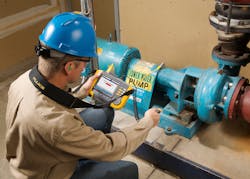Motor and drive system technology continues to advance throughout the industry. Oftentimes, this increased complexity presents a challenge to the teams who are making sure the equipment runs at peak performance. Even then, some motor failures result from mechanical failures or even problems introduced at installation. Thus, maintenance teams need to take different categories of components into consideration when troubleshooting motor problems.
Understanding the common reasons for motor failure and knowing how to troubleshoot and repair these systems can prevent costly downtime and improve operational efficiency. The following are common reasons motors fail.Power issues
Transient voltage spikes. Transient voltages, like the name suggests, can come from several sources, either inside or outside a plant. They can strike distribution systems from loads for adjacent equipment turning on or off, power factor correction capacitor banks, and even weather events. These transients, which vary widely in amplitude and frequency, can erode or break down the insulation in motor windings. Determining the source of these transients is often difficult because of their seemingly randomness or infrequency of occurrences. Symptoms can show up in different ways. For instance, transient voltage may appear on control cables that don’t cause direct equipment damage but still can trip components and disrupt operations.
Impact: Insulation breakdown on motor windings leads to early motor failure and unplanned downtime
Tool to measure and diagnose: Power quality and motor analyzer, monitoring devices
Degree of criticality: High
Voltage imbalance. The 3-phase distribution systems that are common in industrial plants often serve single-phase loads. An imbalance in impedance or load distribution can, in turn, contribute to imbalance across all three of the phases. Potential faults may be found in the cabling to the motor, the terminals at the motor, and potentially in the motor windings themselves. This imbalance can lead to stresses in each of the phase circuits in a 3-phase power system. All three phases of voltage should always have the same magnitude.
Impact: Imbalance creates excessive current in one or more phases that then increases operating temperatures, leading to insulation breakdown.
Tool to measure and diagnose: Power quality and motor analyzer, monitoring devices
Degree of criticality: Medium
Harmonic distortion. Harmonics are essentially any unwanted additional source of high-frequency AC voltages or currents supplying energy to the motor windings. This additional energy is not used to turn the motor shaft but instead circulates in the windings and ultimately contributes to internal energy losses. These losses dissipate as heat that, over time, will deteriorate the insulation properties of the windings. Some harmonic distortion of the current is normal on any part of the system serving electronic loads. To investigate harmonic distortion, use a power quality analyzer to monitor electrical current levels and temperatures at transformers to ensure that they are not overstressed. Each harmonic has a different acceptable level of distortion, which is defined by standards such as IEEE 519-1992.
Impact: Motor efficiency decreases, increasing costs and operating temperatures
Tool to measure and diagnose: Power quality and motor analyzer, monitoring devices
Degree of criticality: Medium
Excess shaft voltage. If motor shaft voltages exceed the insulating capacity of the bearing grease, flashover currents will occur and impact the outer bearing, causing pitting and grooving on the bearing races. The first signs of this are noise and overheating. As the bearings begin to lose their shape and metal fragments mix with the grease, bearing friction increases. This often destroys the bearing within a few months. Bearing failure is an expensive problem to repair and leads to costly downtime. Measuring shaft voltage and bearing current is an important diagnostic step to prevent excessive shaft voltage. Since shaft voltage is only present while the motor is energized and rotating, you will use a carbon brush probe attachment for the measurement on a portable oscilloscope.
Impact: Arcing across bearing surfaces create pitting and fluting resulting in excessive vibration and eventual bearing failure.
Tools to measure and diagnose: Portable oscilloscope, motor drive analyzer, carbon brush probe attachment
Degree of criticality: High
Variable-frequency drive (VFD) issues
Reflections on drive output PWM signals. Variable-frequency drives use a pulse-width modulation (PWM) technique to control the output voltage and frequency to a motor. Reflections can be generated when there is an impedance mismatch between the source and load. Impedance mismatches can come from improper installation, improper component selection, or when equipment degrades over time. In a motor drive circuit, the peak of the reflection can be as high as the DC bus voltage level. Generally, reflections or transients >50% of nominal voltage are problematic.
Impact: Motor-winding insulation breakdown leads to unplanned downtime.
Tools to measure and diagnose: Portable oscilloscope, insulation multimeter
Degree of criticality: High
Sigma current. Sigma currents are stray currents that circulate in a system. Sigma currents are created because of signal frequency, voltage level, capacitance, and inductance in conductors. These stray currents can circulate through protective earth systems and cause nuisance tripping or lead to excess heat in windings. Sigma current can be found in motor cabling. It is the sum of the current of the three phases at any one point in time. In a perfect situation, the sum of the three currents would equal zero. Thus, the return current from the drive would be equal to the current to the drive. Sigma current can also be understood as asymmetrical signals in multiple conductors that can capacitively couple currents into the ground conductor.
Impact: Mysterious circuit trip due to protective earth current flow
Tool to measure and diagnose: Portable oscilloscope
Degree of criticality: Low
Motor overloading. As the name suggests, motor overload happens when a motor is under excessive load. Typical symptoms for motor overload are excessive current draw, insufficient torque, and overheating. Excessive motor heat is a major cause of motor failure. An overloaded motor’s individual components, such as bearings, motor windings, and other components, may appear to operate normally, but the motor will run hot. Because of this, checking for overload is a good place to start when troubleshooting motors. Some 30% of motor failures are caused by overloading, so it is important to know how to identify and measure motor overloading.
Impact: Premature wear on motor electrical and mechanical components leading to permanent failure
Tools to measure and diagnose: Infrared camera, industrial logging multimeter
Degree of criticality: High
Mechanical
Shaft misalignment. Shaft misalignment occurs when the motor drive shaft is not in correct alignment with the load, or the component that couples the motor to the load is misaligned. Professionals often erroneously think a flexible coupling eliminates and compensates for misalignment, but a flexible coupling only protects the coupling from misalignment. Even with a flexible coupling, a misaligned shaft will transmit damaging cyclical forces along the shaft and into the motor. These forces cause excess wear on the motor and increase the apparent mechanical load. Misalignment also might feed vibration into both the load and the motor drive shaft. Types of misalignment include:
- Angular misalignment: Shaft centerlines intersect but are not parallel.
- Parallel misalignment: Shaft centerlines are parallel but not concentric.
- Compound misalignment: A combination of parallel and angular misalignment. Note: Almost all misalignment is compound misalignment. However, technicians often talk about misalignment as two separate types because it is a best practice to correct misalignment by addressing angular and parallel components separately.
Impact: Premature wear in mechanical drive components that leads to premature failures
Tools to measure and diagnose: Vibration tester, vibration analyzer, vibration sensors, shaft alignment tool
Degree of criticality: High
Shaft imbalance. Imbalance occurs in a rotating part where the center of mass does not lie on the axis of rotation. A heavy spot exists somewhere on the rotor. Although motor imbalance cannot be eliminated, it is possible to identify a normal range and rectify the problem. Imbalance can be caused by numerous factors, including:
- Accumulation of dirt.
- Missing balance weights.
- Manufacturing variations.
- Uneven mass in motor windings or other wear-related factors.
Impact: Wear in drive components leads to premature failures
Tools to measure and diagnose: Vibration tester, vibration analyzer, vibration sensors
Degree of criticality: High
Looseness. Rotating looseness occurs when too much clearance exists between rotating and stationary parts of a machine, such as a bearing. Non-rotating looseness occurs between two normally stationary parts, such as a foot and a foundation, or a bearing housing and a machine.
Impact: Wear in mechanical drive components leads to failures
Tools to measure and diagnose: Vibration tester, vibration analyzer, vibration sensors, laser shaft alignment tool
Degree of criticality: High
Bearing wear. A failed bearing has increased drag, emits more heat, and has lower efficiency because of a mechanical, lubrication, or wear problem. Bearing failure can be caused by:
- A heavier load than designed for.
- Inadequate or incorrect lubrication.
- Ineffective bearing sealing.
- Shaft misalignment.
- Incorrect fit.
- Normal wear.
- Induced shaft voltages.
Bearing failure creates additional problems that accelerate motor failure. In fact, 13% of motor failures are caused by bearing failure, and more than 60% of the mechanical failures in a facility are caused by bearing wear. Thus, knowing how to troubleshoot bearing wear is an important skill.
Impact: Wear on rotating components results in bearing failure
Tool to measure and diagnose: Vibration tester
Degree of criticality: High
Improper installation factors
Soft foot. Soft foot is a condition where the mounting feet of a motor or driven component are uneven, or the surface on which the mounting feet sit is not even. Soft foot can frustrate professionals who try tightening the mounting bolts on the feet only to introduce new strains and further misalignment. Soft foot often happens between two diagonally positioned mounting bolts— such as how an uneven chair or table tends to rock in a diagonal direction. There are two kinds of soft foot:
- Parallel soft foot: When one of the mounting feet sits higher than the other three.
- Angular soft foot: When one of the mounting feet is not parallel or “normal” to the mounting surface.
In both cases, soft foot can result from an irregularity in the machine mounting feet or in the mounting foundation on which the feet rest. Any soft foot condition should be identified and remedied before a shaft is properly aligned. A quality laser alignment tool typically can identify a soft foot problem.
Impact: Misalignment of mechanical drive components
Tool to measure and diagnose: Laser shaft alignment tool
Degree of criticality: Medium
Pipe strain. Pipe strain occurs when stresses, strains, and forces from connected infrastructure transfer backward onto the motor and drive to introduce misalignment. The most common example of pipe strain is in motor/pump combinations, where something creates force to the pipe works such as:
- A shift in the foundation.
- A new valve or another component installation.
- An object striking, bending, or pressing on a pipe.
- Broken or absent pipe hangers or mounting hardware.
Forces such as these can put an angular or offset force on the pump, which, in turn, causes the motor/pump shaft to become misaligned. Thus, it is recommended that you check machine alignment routinely. Precision alignment is temporary and can change over time.
Impact: Shaft misalignment and subsequent stresses on rotating components, leading the premature failures
Tool to measure and diagnose: Laser shaft alignment tool
Degree of criticality: Low
Strategies to prevent motor failures
Motors and their control systems are ubiquitous in critical processes throughout manufacturing and industrial facilities. If they fail, the cost of downtime as well as repairing or replacing motor can be substantial. That’s why your maintenance teams need the appropriate skills, training, and tools to properly prioritize equipment criticality, monitor equipment health, and develop a preventive maintenance program that keeps motors in good working order to help forestall failures. In addition, maintenance teams need the training and procedural knowledge to troubleshoot intermittent problems to avoid failures because of normal operating stresses.
Implement the following four strategies to prevent premature failures in motors, drives, and rotating components:
- Document normal operating conditions, machine specifications, and performance tolerance ranges.
- At installation, be sure to capture and document critical operating measurements. Also, track these measurements before and after maintenance and at other intervals, depending on their criticality.
- Develop an archive of reference measurements to facilitate trend analysis and identify changes in status and conditions. Modern computerized maintenance management systems (CMMSs) can help manage data and help with this type of trend analysis.
- Plot individual measurements to establish a baseline, and then capture measurements over time to determine trends. It is recommended that any change in the trend line of more than ±10 % to 20 % (or any other percentage determined, based on your system performance or criticality) should be investigated to the root cause to understand why the issue is occurring.
Silvey is an application specialist with Fluke Corp., Everett, Wash. He can be reached at [email protected].







